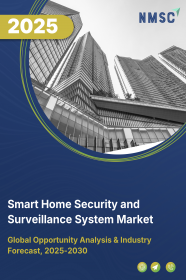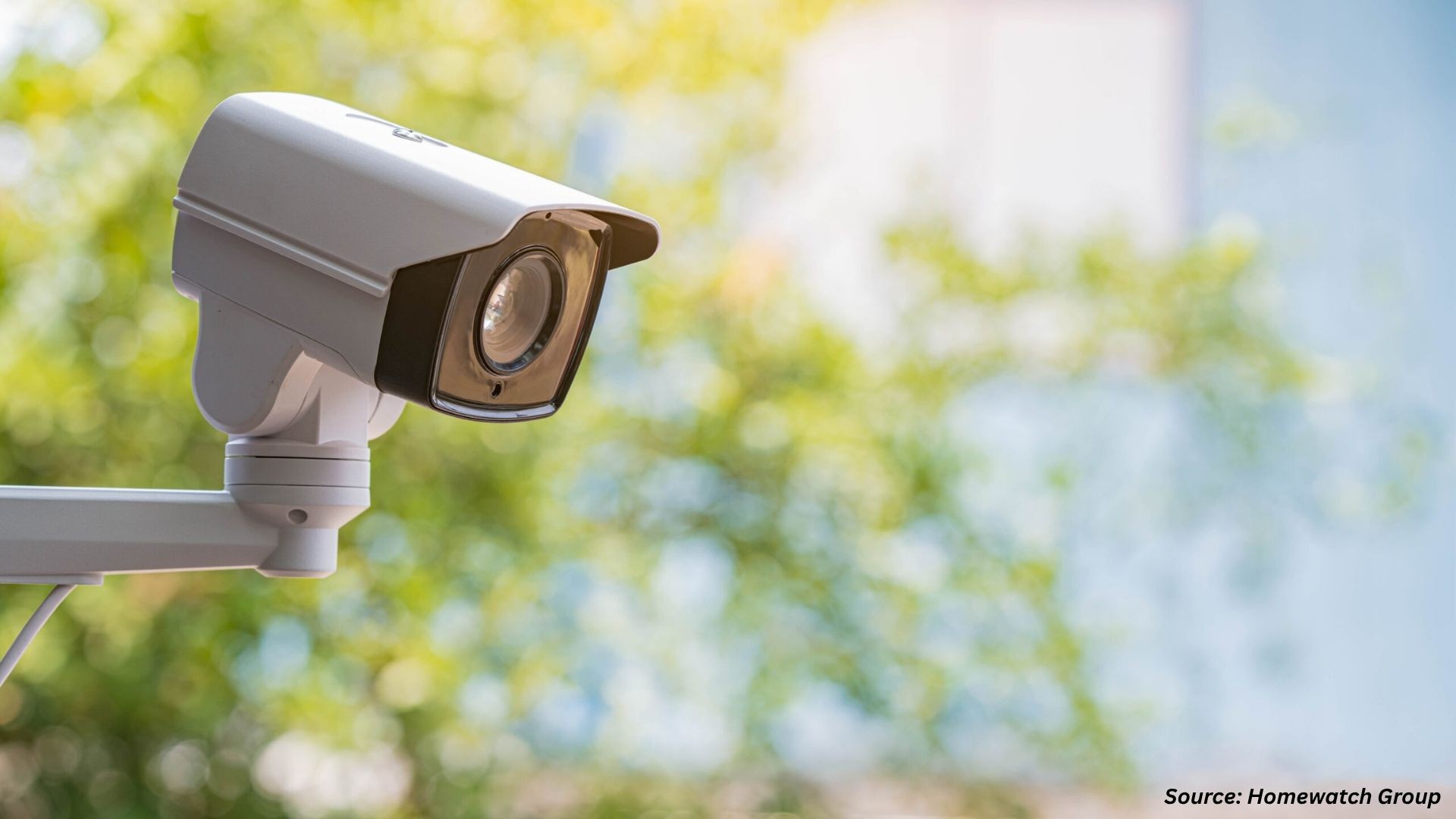
Smart Home Security and Surveillance System Market by Components (Hardware, Software, and Service), by Product Type (Smart Cameras, Smart Door Locks, Smart Alarms, Sensors and Others), by Connectivity Type (Wired and Wireless), by Communication Module (Professionally Monitored, and Self-Monitored), by Installation (DIY Installation and Professional Installation), and by Sales Channel (Online and Offline)–Global Opportunity Analysis and Industry Forecast 2025-2030.
Smart Home Security and Surveillance System Industry Overview
The global Smart Home Security and Surveillance System Market size was valued at USD XYZ billion in 2024, and is expected to be valued at USD XYZ billion by the end of 2025. The industry is projected to grow further, hitting USD XYZ billion by 2030, with a CAGR of XY% between 2025 and 2030.
The smart home security and surveillance market is witnessing substantial growth, fuelled by factors such as the growing acceptance of smart home technologies, heightened focus on security concerns, and continuous technological advancements.
Nevertheless, cybersecurity concerns, particularly those related to data privacy and potential vulnerabilities, continue to restrain market adoption and trust in interconnected solutions.
Despite these challenges, the development of advanced real-time monitoring technologies presents a compelling opportunity, especially as companies seek to deliver enhanced, AI-driven surveillance capabilities tailored to evolving consumer needs. The industry is poised for sustained expansion, supported by innovation and increasing demand across both developed and emerging markets.
Growing Adoption of Smart Home Technologies Fuels the Growth of the Market
The growing adoption of smart home technology is driving the smart home security and surveillance system market growth. This demand for enhanced living experiences extends directly to security, where homeowners seek the ease of remotely monitoring their property and receiving real-time alerts about any unusual activity. This trend is particularly evident among individuals, homeowners, and early technology adopters, who perceive a strong value in these security devices.
Heightened Focus on Security Concerns Boosts the Growth of the Market
A significant driver propelling the smart home surveillance industry is the heightened focus on enhanced security measures for residential properties. With a global increase in crime and a growing awareness of potential threats, homeowners are increasingly investing in solutions that offer peace of mind.
Smart home security systems, including surveillance cameras, smart locks, and motion sensors, provide a sense of control and the ability to monitor their homes remotely. The ability to receive real-time notifications and access live video feeds from anywhere at any time is a major draw for consumers.
The need to strengthen security and protection measures in residential areas is further amplified by increasing urbanization, which is driving the smart home security and surveillance system market demand.
Integration of AI and ML Boosts the Market
The relentless pace of technological advancements is a fundamental catalyst for the growth of the smart home security and surveillance market trends. Innovations such as Artificial Intelligence (AI) and machine learning (ML) are being integrated into security devices, enabling sophisticated features like facial recognition, person detection, and behavioural analysis.
Enhanced cellular network and internet connectivity ensure faster and more reliable communication between devices and user interfaces. The development of high-definition cameras with night vision, improved motion detection sensors, and efficient cloud storage capabilities is making these systems more effective and user-friendly.
Furthermore, the increasing emphasis on interoperability and compatibility between devices from different brands allows consumers to create comprehensive and tailored smart home setups.
Cybersecurity Concerns Hinder the Smart Home Security and Surveillance System Market Expansion
Despite the numerous benefits, privacy and security concerns remain significant restraints for the widespread adoption of smart home security systems. Smart home devices often collect vast amounts of personal data, including audio and video recordings, usage patterns, and personal preferences.
The potential for data leaks, misuse of information, and unauthorized access by cybercriminals raises legitimate fears among consumers. For example, surveillance video can be used by attackers to blackmail or plan criminal schemes. Concerns about storing, processing and sharing of data with third parties also contribute to this restraint.
Advanced Real-Time Monitoring Solutions Create Future Growth Opportunities for the Market
A significant opportunity for players in the smart home security and surveillance market lies in the development and deployment of advanced real-time monitoring solutions powered by Artificial Intelligence (AI). By leveraging AI and machine learning, security systems can move beyond simple detection to provide more intelligent and proactive protection.
AI can enable real-time analysis of situations, allowing for faster responses to potential threats and reducing false alarms, making these systems more reliable and efficient. The ability to offer sophisticated features like vehicle detection, person detection, face detection, and license plate recognition (LPR) through AI-powered cameras presents a substantial growth potential for companies that can innovate in this area.
Market Segmentation and Scope of the Study
The smart home security and surveillance system market report is segmented on the basis of component, product type, connectivity, communication module, installation, sales channel and region. On the basis of component, the market is divided into hardware, software, and service. On the basis of product type, the market is divided into smart cameras, smart door locks, smart alarms, sensors and others. On the basis of connectivity type, the market is divided into wired and wireless. On the basis of communication module, the market is divided into professionally monitored, and self-monitored. On the basis of installation, the market is divided into DIY installation and professional installation. On the basis of sales channel, the market is divided into online and offline. Regional breakdown and analysis of each of the aforesaid segments include regions comprising North America, Europe, Asia-Pacific, and RoW.
Geographical Analysis
North America dominates the smart home security and surveillance system market share due to widespread adoption of smart technologies and a well-established technological infrastructure. High consumer awareness regarding home safety and increasing demand for connected security solutions create a mature market environment.
The integration of artificial intelligence into security systems enhances functionality, offering personalized and proactive monitoring capabilities. Substantial investment in home automation and security further reinforces the region's leadership.
As technology continues to evolve, North American consumers show a sustained interest in upgrading to more advanced systems. The presence of key market players and early product launches also contribute to this competitive edge. This combination of demand, innovation, and infrastructure places North America at the forefront of global market share.
Europe follows closely behind, marked by strong growth influenced by heightened public concern around privacy and personal security. Increasing internet penetration and digital literacy across European nations encourage the adoption of smart surveillance systems.
Britain leads the region in video surveillance growth, reflecting strong market engagement. The focus on integrating security technology into residential environments supports the expansion of smart home solutions. Regulatory initiatives aimed at enhancing consumer data protection and encouraging safer living spaces further propel demand.
Smart home technology is being adopted not only for convenience but also as a proactive measure to address rising urban crime. European consumers value both security and privacy, which guides product development and adoption trends. As a result, the region continues to experience steady and sustainable market growth.
Asia-Pacific is rapidly emerging as a high-potential region for smart home security, fueled by accelerating urbanization and rising household incomes. A strong base of manufacturing hubs and innovation centers enables affordable and advanced product development.
Governments across the region are investing heavily in smart city infrastructure, which includes enhanced residential safety measures. As more consumers move into urban areas, the demand for intelligent security systems rises sharply.
Growing tech-savviness among consumers and increased smartphone penetration drive further adoption. Countries like China, India, and South Korea are leading in both consumption and production of smart home security products. Regional partnerships and public-private collaborations also support innovation and market penetration. This combination of factors makes Asia-Pacific one of the fastest-growing regions in the global market.
The Rest of the World, including South America, the Middle East, and Africa, presents promising but currently underdeveloped opportunities in the smart home security sector. Adoption levels remain lower due to affordability and infrastructural gaps, but interest in security solutions is on the rise. Increasing exposure to global smart home trends and growing concerns around home safety are encouraging gradual market development.
Local governments and private firms are starting to invest in modern housing projects and digital infrastructure. As internet and mobile access expand, consumer interest in connected devices is expected to follow. Affordability of smart security products is gradually improving, making them accessible to a wider audience.
Educational campaigns and marketing efforts by key players are also helping raise awareness. While currently in an early stage, these regions hold long-term growth potential as barriers continue to reduce.
Key Players and Their Strategic Moves in the Smart Home Security Market
The smart home security and surveillance system industry comprises of various market players such as Honeywell International, Inc., SimpliSafe, Schneider Electric, Vivint, Arlo Technologies, Yale, Johnson Controls, ABB Ltd, Philips Corporation, and Samsung Electronics, Google LLC, Apple Inc., Ring LLC, Zmodo, Hikvision Digital Technology Co., Ltd. These market players are adopting strategies such as product launches to stay competitive and maintain their market positions.
Leading players in the global smart home security and surveillance industry are strategically focusing on innovation and integration to capture a larger market share of the expanding market size. For instance, key players like Amazon, Google, Apple, Ring, and ADT are continuously introducing new smart cameras, doorbells, and comprehensive security systems with enhanced mobile connectivity and remote monitoring capabilities.
The development of smart city projects and the increasing focus on energy management is creating significant opportunities for the deployment of advanced surveillance technologies. For example, Panasonic's launch of a Smart Home Experience Centre in India highlights the strategic focus on regional markets and the integration of security with wellness and convenience. Moreover, the trend towards DIY security solutions and the increasing availability of affordable smart devices are expanding the consumer base and creating new avenues for market growth.
Key Benefits
-
The report provides quantitative analysis and estimations of the market from 2025 to 2030, which assists in identifying the prevailing market opportunities.
-
The study comprises a deep dive analysis of the current and future smart home security and surveillance system market trends to depict prevalent investment pockets in the market.
-
Information related to key drivers, restraints, and opportunities and their impact on the smart home security and surveillance system sector is provided in the report.
-
Competitive analysis of the players, along with their market share is provided in the report.
-
SWOT analysis and Porters Five Forces model is elaborated in the study.
-
Value chain analysis in the market study provides a clear picture of roles of stakeholders.
Smart Home Security and Surveillance System Market Key Segments
By Components
-
Hardware
-
Software
-
Service
By Product Type
-
Smart Cameras
-
Smart Door Locks
-
Smart Alarms
-
Sensors
-
Others
By Connectivity Type
-
Wired
-
Wireless
By Communication Module
-
Professionally Monitored
-
Self-Monitored
By Installation
-
DIY Installation
-
Professional Installation
By Distribution Channel
-
Online
-
Offline
By Region
-
North America
-
The U.S.
-
Canada
-
Mexico
-
-
Europe
-
The UK
-
Germany
-
France
-
Italy
-
Spain
-
Denmark
-
Netherlands
-
Finland
-
Sweden
-
Norway
-
Russia
-
Rest of Europe
-
-
Asia Pacific
-
China
-
Japan
-
India
-
South Korea
-
Australia
-
Indonesia
-
Singapore
-
Taiwan
-
Thailand
-
Rest of Asia Pacific
-
-
RoW
-
Latin America
-
Middle East
-
Africa
-
Key Players
-
Honeywell International, Inc.
-
SimpliSafe
-
Schneider Electric
-
Vivint
-
Arlo Technologies
-
Yale
-
Johnson Controls
-
ABB Ltd
-
Philips Corporation
-
Samsung Electronics
-
Google LLC
-
Apple Inc.
-
Ring LLC
-
Zmodo
-
Hikvision Digital Technology Co., Ltd.
REPORT SCOPE AND SEGMENTATION:
|
Parameters |
Details |
|
Market Size in 2024 |
USD XYZ billion |
|
Revenue Forecast in 2030 |
USD XYZ billion |
|
Growth Rate |
CAGR of XY% from 2025 to 2030 |
|
Analysis Period |
2024–2030 |
|
Base Year Considered |
2024 |
|
Forecast Period |
2025–2030 |
|
Market Size Estimation |
Billion (USD) |
|
Growth Factors |
|
|
Countries Covered |
28 |
|
Companies Profiled |
15 |
|
Market Share |
Available for 10 companies |
|
Customization Scope |
Free customization (equivalent up to 80 working hours of analysts) after purchase. Addition or alteration to country, regional, and segment scope. |
|
Pricing and Purchase Options |
Avail customized purchase options to meet your exact research needs. |




















 Speak to Our Analyst
Speak to Our Analyst
























